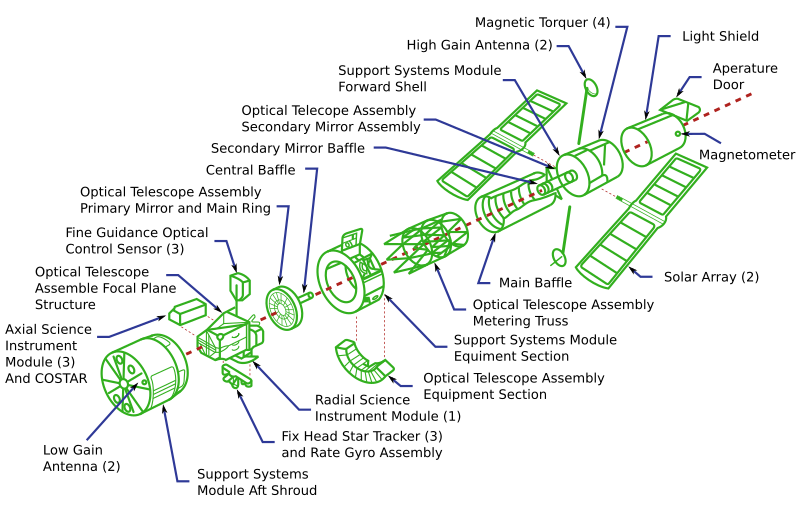Hubble turns 20: a retrospective in pictures

The Hubble Space Telescope broke free from its terrestrial confines on April 24, 1990 aboard the space shuttle Discovery. In the 20 years since, it has seen near total failure and has brought back some of the most important and astounding images of the Universe humankind has ever seen. In celebration of Hubble's 20 years of service, Nobel Intent has taken a moment to look back at some of the most significant images that the flying observatory has brought us.
Saturn
Image Credit: NASA, ESA, J. Clarke (Boston University), and Z. Levay (STScI)
While the HST has given us a glimpse of some of the farthest reaches of the Universe, some of its most incredible images come from an object in its own backyard: the planet Saturn. Seen in the image along with the planet itself is an aurora around one of Saturn's magnetic poles. Combined with measurements from the Cassini spacecraft, it taught astronomers that Saturn's aurora differ from their counterparts on Earth and Jupiter.
Light "echo"
Reminiscent of Vincent van Gogh's "Starry Night" is an image of a light "echo" illuminating trillions of miles of interstellar dust around the Red Giant star V838 Monocerotis. The image, taken in 2004, was snapped two years after a brief period of the sudden brightening of V838 Monocerotis—it shows the dust that exists two light years from the main star. The dust and gas are believed to be the remnants from a previous brightening event that occurred tens of thousands of years ago. Hubble has monitored this light pulse since near the beginning of the event and has continued to follow its progress through the interstellar dust in the years since.
Pillars of creation
Perhaps one of the most recognizable and iconic images ever sent back by the HST is that of the Pillars of Creation within the Eagle Nebula. Released in 1995, the image gave the first glimpse of what a stellar nursery looks like. Each "pillar" is a massive cloud of dust, light-years in length, inside of which massive, dense pockets of molecular gas begin to collapse under their own weight and form new stars.
M74
Not only has Hubble revealed the beauty of planets, stars, dust, and gas, it has revealed the utter beauty inherent in other galaxies. This image, of spiral galaxy M74, doesn't represent any piece of breakthrough science, or pose any new questions in astrophysics; it simply shows the beauty that can be contained in the images returned by Hubble.
Gravitational lensing
Image Credit: NASA, ESA, Richard Ellis (Caltech) and Jean-Paul Kneib (Observatoire Midi-Pyrenees, France)
Einstein's theory of general relativity states that gravity is really a manifestation of mass-energy density in the Universe and that everything, light included, is affected by this since it alters the nature of the fabric of spacetime itself. A corollary to this central hypothesis is that areas of high density, such as stars, or, on a larger scale, galactic clusters, will cause light to appear bent as though it passed through a lens—actually, light will follow a straight line in bent space, a geodesic. This image, looking through galactic cluster Abell 2218, allowed astronomers to use the cluster's immense mass to gravitationally lense the light coming from a baby galaxy 13.4 billion light years away. It clearly highlights the (correct) prediction that mass can affect the very path of light and lends clear experimental support to general relativity being correct at large scales.
Ultra Deep Field
Image Credit: NASA, ESA, G. Illingworth (UCO/Lick Observatory and the University of California, Santa Cruz), R. Bouwens (UCO/Lick Observatory and Leiden University), and the HUDF09 Team
I have been to a number of major art museums around the world, and have looked at what are considered to be some of the greatest works of art that mankind has produced. To me, this image belongs in the pantheon of great works of art alongside the other triumphs of humanity. The Ultra-deep field image taken by Hubble shows the sheer enormity of space itself. Each speck of light in this image, of the deepest reaches of the Universe, is an entire separate galaxy made up of billions of stars each. In my opinion, this image puts us in perspective and shows us the beauty of the cosmos in a way that cannot be otherwise shown. While there was once a time where a single human could know all there was to know in the collective of human knowledge, this picture shows exactly how little we truly know, yet how aware of that fact we are.
After 20 years of service, the Hubble Space Telescope has expanded our horizons beyond our wildest imagination. It has answered a number of outstanding astronomical and astrophysical questions, yet, as any good work of science does, has opened the door to countless more. As its successor, the James Webb Space Telescope, is built and prepped to be launched in 2014, Hubble will live out its last days carrying out the mission it always has. It is calculated that without an orbital boost, it will deorbit sometime in the 2020s. At the end, it is only one of many telescopes that will reside in space all bringing us data that could never be obtained from the confines of Earth, all advancing our knowledge at a rate previously unimagined by humankind.






No comments:
Post a Comment